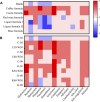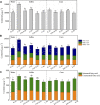Sensory attributes, chemical and microbiological properties of cigars aged with different media
- PMID: 37941725
- PMCID: PMC10628719
- DOI: 10.3389/fbioe.2023.1294667
Sensory attributes, chemical and microbiological properties of cigars aged with different media
Abstract
Introduction: Aging is an important process to improve the quality of cigar, but the effect of aging with media on cigar has not been reported.Therefore, this study aimed to prepare different aging media and clarify the influence of media on cigar quality. Methods: Effective media were first screened by sensory evaluation, then the effects of aging media on the chemical composition and microbial community of cigar were investigated. Results: The results showed that: 1) As aging media, coffee formula and cocoa formula could optimize the smoke and aroma characteristics of cigar, and 30 days was the appropriate period for cigar aging. 2) Aging with coffee or cocoa media could increase the content of amino acids, non-volatile organic acids, malic acid and aroma components. Particularly, the content of aroma components increased from 2.48 mg g-1 (W-30) to 3.21 mg g-1 (C-30) and 3.70 mg g-1 (K-30), respectively. 3) Aging with coffee can improve the diversity of bacteria and fungi on the cigar surface and change the succession rule of bacterial community. In contrast, aging with cocoa had no significant effect on microbial diversity of cigar. Discussion: In this study, the influence of aging media on cigar quality was analyzed multidimensionally for the first time, which provided a reference for the development of new aging media and technologies to improve cigar quality.
Keywords: aging; chemical composition; cigar; community succession; medium; sensory quality.
Copyright © 2023 Hu, Cai, Jia, Fan, Zhu, Zhang, Wang, Liu and Li.
Conflict of interest statement
Authors WH, WC, YJ, BZ, JF, QZ, YW, and DL were employed by China Tobacco Sichuan Industry Co., Ltd. The remaining author declares that the research was conducted in the absence of any commercial or financial relationships that could be construed as a potential conflict of interest.
Figures









References
-
- Carcea M., Danesi I., De Gara L., Diretto G., Fanali C., Raffo A., et al. (2023). Chemical composition and sensory profile of the Italian espresso coffee powder and beverage under different roasting conditions. Eur. Food Res. Technol. 249 (5), 1287–1301. 10.1007/S00217-023-04213-0 - DOI
-
- Chen Y., Sun X., Zheng Z. J., Cai W., Xue F., Liu Y. F., et al. (2023). Influences of feed fermentation on chemical compositions and bacterial diversity of cigar filler tobacco. Acta Tabacaria Sin. 29 (1), 106–115. 10.16472/j.chinatobacco.2021.064 - DOI
-
- Fan J. Y., Zhang L., Li A. J. (2016). Study on the production key technology of handmade cigar. J. Anhui Agric. Sci. 44 (6), 104–105. 10.13989/j.cnki.0517-6611.2016.06.035 - DOI
-
- Fan J. Y., Zhang L., Xu H., Xiang X. H., Zhang W., Zhou L., et al. (2023). Research progress of cigar curing and alcoholizing technology. China Food Ind. 2, 77–79.
LinkOut - more resources
Full Text Sources
Research Materials

